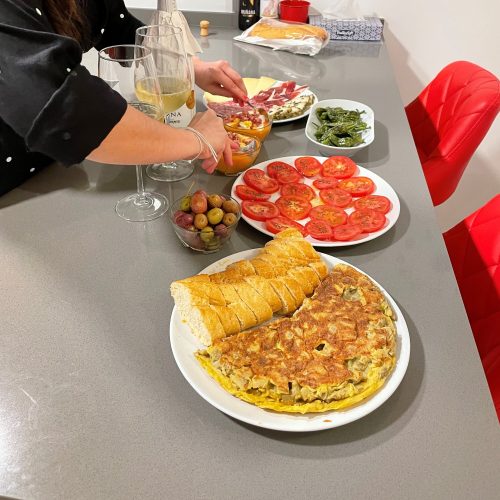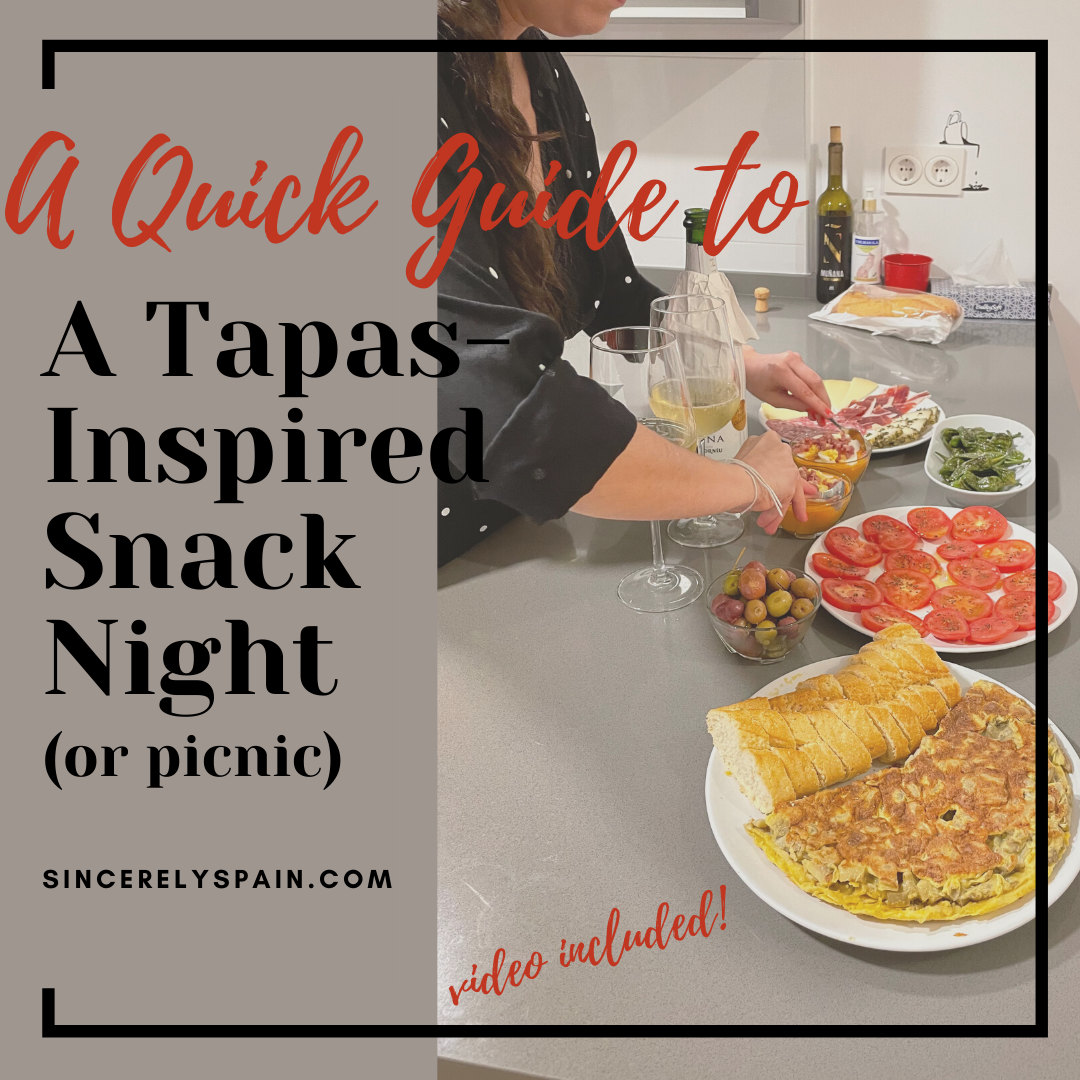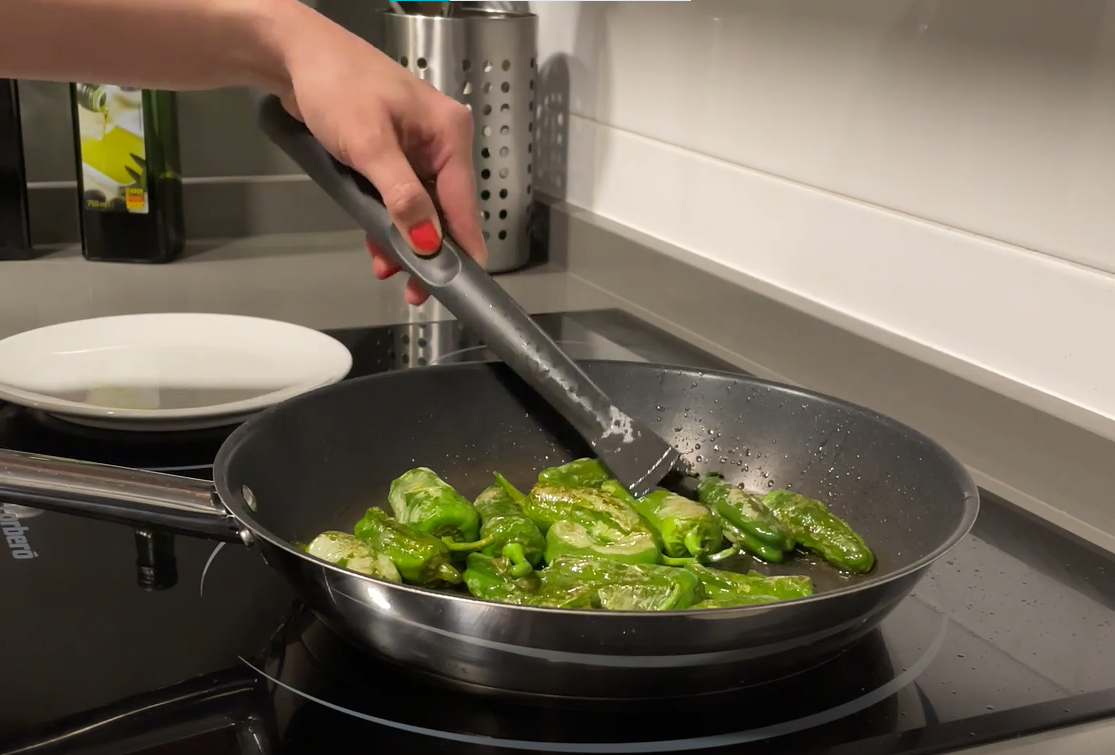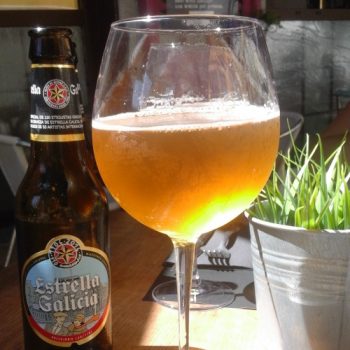
A Quick Guide to a Spanish Tapas-Inspired Snack Night
Dear Casey,
As I’m sure you’ve noticed by now, you can find resources on this blog related to just about every aspect of expat life and the Spanish culture. However, one of our favorite things about the culture that we enjoy partaking in as well as talking about is the food! Whether you’re new to Spanish cuisine and want to know where to start or whether you love tapas and have been missing them, this is the perfect guide to help you easily bring a taste of Spain into your at-home snack night or on-the-go picnic.

But first, what are tapas?
If you’re going to go through the trouble of creating a tapas spread to share with your family or friends, you’re going to want to know how to explain what tapas are. For full details, be sure to read up on our post about the tapas culture in Granada, Spain (which is slightly different from the pintxos culture in Bilbao). Basically, tapas are small plates of food or snacks that are consumed together with drinks.
Depending on the region of Spain you are in, they may be provided free of cost when you order a beverage at a bar. Whether you make them at home or eat them out, pretty much any food can be turned into a tapa by serving it in small portions. For the sake of this quick guide, however, we have opted for the more basic tapas that won’t demand as much preparation time.
A Video Guide
For the visual folks, check out this video in which Dani walks you through all of the tapas and the preparation explained below in more detail.
Our go-to tapas
Aceitunas
No Spanish tapas night would be complete without at least one variety of Spanish olives. In the video, Dani goes with a version called morada rayada which includes purple (morada) olives. Another favorite of ours is gazpacho which is prepared in a vinegar with an orange tint and includes a mixture of pickled onions, carrots, and pickles as well. If you have a market near you, this is a great opportunity to try something new and pick up an assortment of aceitunas that take your fancy.

Queso
Cured and semi-cured cheeses are super popular in the Spanish diet and should not be missed. For details to help you choose the queso best suited to your tastes, check out this cheese guide. In the video, Dani opts for a semicurado manchego cheese and a semicurado oveja (sheep’s) cheese with rosemary and thyme coating.
Jamón de bellota
Cured ham is another hallmark of Spanish cuisine and you can find further details of the different varieties that exist in this article. If you can find it where you are, we recommend jamón de bellota, which is the most expensive but definitely the tastiest of the Spanish hams. Made from Iberian pigs who have been fed a natural diet of acorns (bellotas), it has a creamier melt-in-your-mouth flavor.
Tortilla española
The Spanish omelette is a staple as well. While you can find plenty of store-bought versions in Spain, we recommend making it yourself with the help of this article and its accompanying video. When we make tortilla de patatas on the same day as a snack night we serve it hot, right out of the pan. Otherwise, you can opt for serving it cold or reheating it in the microwave. Either way is traditional.

Ensalada de tomate
Perhaps the simplest salad you’ve ever made, this dish consists of nothing more than fresh tomatoes, salt, and olive oil (and green herbs if you’d like). Simply slice your tomatoes into thin, round slices, add the seasoning and pour a nice Spanish extra virgin olive oil over the plate. If you think Spanish olive oil is difficult to find near you, think again! Many of the EVOO that is marketed as Italian is actually only bottled in Italy (but made in Spain), check the fine print if you don’t believe us!
Salmorejo
We would recommend including a cold soup in your snack night such as salmorejo, gazpacho, or ajoblanco. While you can make any of these from scratch with common ingredients, it requires a food processor or blender. If you are in Spain, going store-bought is a timesaver we often opt for.
If you choose salmorejo, as Dani does in the video, be sure to hard-boil some eggs ahead of time so they have time to cool. When you’re ready, remove the shell(s), slice the egg(s) as you wish, and add them atop the salmorejo. Additionally you’ll want to add some strips of jamón ibérico or pre-cut bits of ham (taquitos de jamón) as Dani does. Finish it off with some salt and olive oil.

Pimientos de Padrón
Perhaps the least common and more intensive dish on our list, pimientos de padrón are really not difficult to make but provide a ‘wow’ factor as it’s likely your dinner or picnic companions will not be familiar with this tapa unless they’ve visited Spain. Start by heating up some EVOO in a pan at medium heat. If you haven’t noticed by now, there’s nothing more Mediterranean than using olive oil in every dish, although you could substitute a different oil for a slightly less authentic taste.
When the oil is warm, add in the washed green peppers (no need to remove the stems) and simply cook them slowly, turning them over with tongs as you go. The peppers will begin to blister, but you don’t want them to burn or cook too quickly so lower the flame if needed. Once the peppers have essentially deflated, remove them from the pan. Dani likes to place them on a plate between paper towels to soak up the excess oil, but this is a personal preference. When you’re ready to serve them, simply add some sea salt and you’re good to go.
For those who have never eaten pimientos de padrón, you’ll want to know just two things. First, this is a finger food so you can feel free to pick the green peppers up by the stem and place them directly into your mouth (discarding the seeds and stem). Second, proceed with caution if you cannot tolerate heat. 90% of pimientos de padrón are mild but every now and again you’ll get a spicy one. That’s the fun of these Spanish peppers!
A wine pairing
Finally, tapas are traditionally served with a beverage, so don’t forget to plan a Spanish twist to your drink choice! A Spanish wine, in particular, would go great with this selection. Check out this article for some basics to help you choose a Spanish wine you’ll love. In addition to the wines mentioned in the aforementioned article, this resource provides some more elaborate wine-based drinks that are popular in Spain if you feel like getting fancy.

We are personally big fans of red wine and, specifically, ribera del duero but in this video Dani opts for Spain’s version of champagne, cava. This particular bottle is Anna de Codorníu which is a white chardonnay cava from the Barcelona region.
We hope this guide helps you bring some Spanish flavor home! Are there any tapas you love and hoped to see on our list, but didn’t? Please let us know if you have any particular questions or recipes you’d like us to share. We’re having a blast making these Spanish food guides and would be happy to oblige.
Happy tapeando!
Sincerely,
Spain




